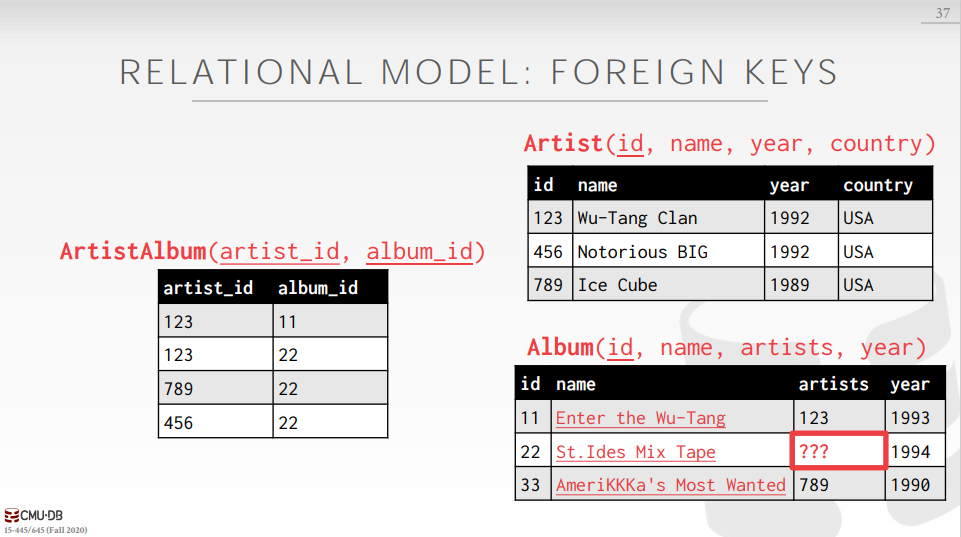RELATIONAL LANGUAGES
User only needs to specify the answer that they want, not how to compute it.
The DBMS is responsible for efficient evaluation of the query.
→ High-end systems have a sophisticated query optimizer that can rewrite queries and search for optimal execution strategies.
- Data Manipulation Language (DML)
- Data Definition Language (DDL)
- Data Control Language (DCL)
Also includes:
→ View definition
→ Integrity & Referential Constraints
→ Transactions
Important: SQL is based on bags (duplicates) not sets (no duplicates).
Outline
- Aggregations + Group By
- String / Date / Time Operations
- Output Control + Redirection
- Nested Queries
- Common Table Expressions
- Window Functions
Aggregates
Functions that return a single value from a bag of tuples:
→ AVG(col)→ Return the average col value.
→ MIN(col)→ Return minimum col value.
→ MAX(col)→ Return maximum col value.
→ SUM(col)→ Return sum of values in col.
→ COUNT(col)→ Return # of values for col.
Aggregate functions can (almost) only be used in the SELECT output list.

DISTINCT AGGREGATES: COUNT, SUM, AVG support DISTINCT

Output of other columns outside of an aggregate is undefined.

GROUP BY
Project tuples into subsets and calculate aggregates against each subset.
Non-aggregated values in SELECT output clause must appear in GROUP BY clause.
HAVING
Filters results based on aggregation computation. Like a WHERE clause for a GROUP BY

STRING OPERATIONS
LIKE is used for string matching.
String-matching operators
→‘%’ Matches any substring (including empty strings).
→‘_’ Match any one character
SQL-92 defines string functions.
→ Many DBMSs also have their own unique functions
Can be used in either output and predicates
SQL standard says to use || operator to concatenate two or more strings together.
DATE/TIME OPERATIONS
Operations to manipulate and modify DATE/TIME attributes.
Can be used in either output and predicates.
Support/syntax varies wildly…
OUTPUT REDIRECTION
Store query results in another table:
→ Table must not already be defined.
→ Table will have the same # of columns with the same types as the input.
Insert tuples from query into another table:
→ Inner SELECT must generate the same columns as the target table.
→ DBMSs have different options/syntax on what to do with integrity violations (e.g., invalid duplicates).
OUTPUT CONTROL
ORDER BY [ASC|DESC]
→ Order the output tuples by the values in one or more of their columns.
LIMIT [offset]
→ Limit the # of tuples returned in output.
→ Can set an offset to return a “range”
NESTED QUERIES
Queries containing other queries.
They are often difficult to optimize.
Inner queries can appear (almost) anywhere in query.
ALL→ Must satisfy expression for all rows in the sub-query.
ANY→ Must satisfy expression for at least one row in the sub-query.
IN→ Equivalent to ‘=ANY()’ .
EXISTS→ At least one row is returned.
WINDOW FUNCTIONS
Performs a “sliding” calculation across a set of tuples that are related.
Like an aggregation but tuples are not grouped into a single output tuples.
The OVER keyword specifies how to group together tuples when computing the window function.
Use PARTITION BY to specify group.
You can also include an ORDER BY in the window grouping to sort entries in each group.
COMMON TABLE EXPRESSIONS
Provides a way to write auxiliary statements for use in a larger query.
→ Think of it like a temp table just for one query.
Alternative to nested queries and views.

















